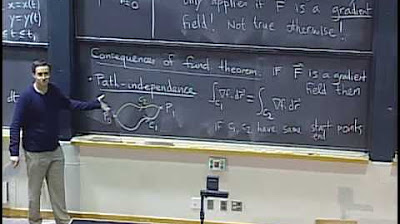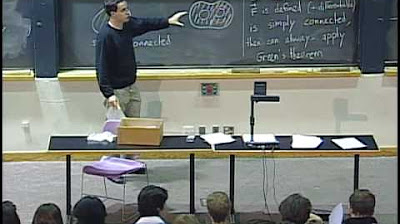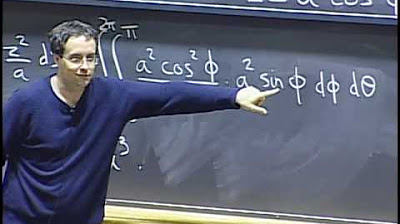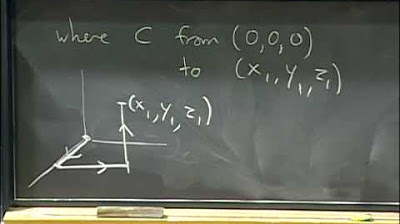Lec 32: Stokes' theorem (cont.); review | MIT 18.02 Multivariable Calculus, Fall 2007
TLDRThis lecture delves into the intricacies of Stokes' Theorem, explaining its relationship with line and surface integrals, and its application in determining path independence in vector fields. The concept of simply connected regions is introduced, with examples to illustrate their properties and implications on gradient fields. The lecture also touches on the topological significance of these concepts, including the classification of surfaces, and concludes with a review of various integral theorems and their applications in calculus.
Takeaways
- 📚 The script discusses Stokes' theorem, which relates line integrals to surface integrals for the curl of a vector field.
- 🔍 It clarifies the difference between line integrals along a curve and surface integrals over a surface, and how they are evaluated.
- 🔄 Stokes' theorem helps in understanding path independence in vector fields and the conditions under which a vector field is a gradient field.
- 🌀 The concept of a simply connected region is introduced, which is essential for applying Stokes' theorem and ensuring path independence of line integrals.
- 📐 Examples are given to illustrate simply connected and non-simply connected regions, such as space with the origin removed versus space with the z-axis removed.
- 📈 The script explains how to prove that a vector field with zero curl in a simply connected region is a gradient field, using Stokes' theorem.
- 🔺 The importance of the choice of surface in applying Stokes' theorem is highlighted, and the surface independence of the result is discussed.
- 📉 The divergence theorem is mentioned as a bridge between surface integrals and triple integrals, showing the relationship between flux and volume integrals of the divergence.
- 🎓 The educational nature of the script is evident, as it is designed to teach and review complex concepts in vector calculus for an audience presumably preparing for an exam.
- 🧠 The script also touches on the topological concepts related to simply connectedness and surface classification, providing a broader context for the mathematical principles.
- 📝 Finally, the script provides a recap of the different types of integrals covered in the course: triple integrals, double integrals, and line integrals, along with their applications and methods of evaluation.
Q & A
What is Stokes' theorem and how does it relate to line integrals and surface integrals?
-Stokes' theorem states that for a closed curve bounding a surface S, with the curve and surface compatibly oriented, the line integral along the curve can be computed as a surface integral of the flux of a different vector field, specifically, the curl of the original field dotted with the normal vector n, over the surface S.
What is the significance of a simply connected region in the context of vector fields and line integrals?
-A simply connected region is one where every closed loop bounds some surface within the region. This property is important because if a vector field has zero curl in a simply connected region, then it is a gradient field, and the line integral of the field is path independent, meaning the result of the integral does not depend on the path taken within the region.
Can you provide an example of a region that is not simply connected?
-An example of a region that is not simply connected is the entire space with the z-axis removed. In this region, there are closed loops (like the unit circle in the xy-plane) that cannot bound a surface without intersecting the removed z-axis.
How does the concept of a simply connected region help in understanding the properties of gradient fields?
-The concept of a simply connected region helps in understanding that if a vector field is defined in such a region and has zero curl, then it must be a gradient field. This implies that the field is conservative, and the line integral of the field over any path between two points is independent of the path taken.
What is the difference between a line integral and a surface integral in terms of their evaluation?
-A line integral takes place along a curve and is evaluated by expressing everything in terms of one variable and then integrating over that variable. A surface integral, on the other hand, is evaluated over a two-dimensional surface and involves expressing the integrand in terms of two variables and then carrying out the double integration.
What is the physical interpretation of the curl of a vector field?
-The curl of a vector field represents the field's tendency to rotate around a point, indicating the amount of 'circulation' or 'vorticity' present at each point in the field. It is a measure of the field's 'rotational' aspect.
Why is the divergence of a curl always zero?
-The divergence of a curl is always zero because the curl operation results in a vector field that is inherently 'divergence-free'. This is a consequence of the fact that the curl represents a rotation, and the divergence would imply a source or sink, which is not the case for a purely rotational field.
What is the significance of the divergence theorem in the context of surface and triple integrals?
-The divergence theorem connects surface integrals to triple integrals by stating that the flux of a vector field through a closed surface can be computed as a triple integral of the divergence of the field over the volume enclosed by the surface. This allows for the conversion of a surface integral into a volume integral, which can be easier to compute in certain cases.
How does the orientation of a surface affect the evaluation of a surface integral?
-The orientation of a surface determines the direction of the normal vector, which is crucial for the evaluation of a surface integral. The choice of normal vector affects the sign of the integral, as the dot product with the vector field will yield different results depending on whether the normal points 'into' or 'out of' the surface.
What is a non-orientable surface and why can't we define flux through it?
-A non-orientable surface, such as a Möbius strip, is a surface that does not have a consistent 'inside' and 'outside' or 'top' and 'bottom'. Because of this property, it is impossible to consistently define a normal vector over the entire surface, which is necessary for the concept of flux. Without a normal vector, we cannot distinguish between positive and negative flux, and thus flux cannot be defined.
What are some common mistakes to avoid when setting up and evaluating triple, double, and line integrals?
-Common mistakes include confusing the types of integrals, not correctly identifying the bounds of integration, using the wrong formula for the differential element (dV, dS, or ds), and not properly accounting for the orientation of the surface or curve when setting up the integral. It's important to carefully match the integrand and the differential element to the geometry of the problem and to ensure that the integral is set up in the correct order of integration.
Outlines
📚 Introduction to Stokes Theorem and Educational Support
The paragraph introduces the concept of Stokes theorem, which relates the line integral around a closed curve to the surface integral of the curl of a vector field over a surface bounded by that curve. It emphasizes the importance of compatible orientation between the curve and surface. The speaker also discusses the support for MIT OpenCourseWare, encouraging donations for high-quality educational resources, and mentions the availability of additional materials from MIT courses.
🔍 Understanding Path Independence and Gradient Fields
This section delves into the concept of path independence in vector fields, particularly gradient fields. It explains how a vector field in a simply connected region with zero curl is a gradient field, implying path independence of line integrals. The paragraph provides a definition of a simply connected region and uses examples to illustrate the concept, including the space with the origin removed and space with the z-axis removed, to demonstrate the difference between simply and non-simply connected regions.
📘 Proof of Path Independence Using Stokes Theorem
The speaker outlines the proof of path independence using Stokes theorem. It discusses how to show that the line integrals along two different paths from a point P0 to P1 are equal by forming a closed curve and applying Stokes theorem. The proof hinges on the ability to find a surface bounded by the closed curve due to the simply connected nature of the region, and the curl of the vector field being zero, leading to the conclusion that the two line integrals are indeed equal.
🏺 Topological Exploration of Simply Connectedness and Surfaces
The paragraph explores the topological concepts related to simply connectedness and the classification of surfaces in space. It contrasts the properties of a sphere, which is simply connected, with those of a torus, which is not. The discussion includes the identification of independent loops on surfaces and how they can be used to classify shapes within space, touching on the foundational achievements of topology in classifying surfaces.
🌀 The Challenge of Non-Orientable Surfaces in Flux Integration
This section discusses the challenges associated with non-orientable surfaces, such as the Mobius strip, when applying Stokes theorem. It explains that non-orientable surfaces cannot have a consistent normal vector, making it impossible to define flux through them. The speaker uses the Mobius strip as an example to illustrate the difficulty in orienting the surface for flux integration and highlights the limitations of such shapes in the context of the theorem.
🔄 Surface Independence in Stokes Theorem and Divergence Theorem
The speaker addresses the concept of surface independence in Stokes theorem, explaining why the choice of surface does not affect the outcome of the theorem. It introduces the divergence theorem, which relates the surface integral over a closed surface to a triple integral over the enclosed volume, and demonstrates that the divergence of the curl of a vector field is always zero, thus ensuring surface independence in flux calculations.
📐 Review of Multiple Integrals and Their Applications
The paragraph provides a comprehensive review of the different types of integrals covered in the course: triple integrals, double integrals, and line integrals. It discusses the setup and evaluation of these integrals in various coordinate systems, including rectangular, cylindrical, and spherical coordinates. The speaker also mentions the applications of triple integrals, such as calculating mass, average value, moment of inertia, and gravitational attraction.
📘 Detailed Explanation of Double and Line Integrals
This section offers a detailed explanation of double and line integrals, focusing on the computation of surface and line integrals using specific formulas for ndS in different contexts. It emphasizes the importance of correctly setting up the integral with the appropriate variables and bounds, and converting between different coordinate systems when necessary. The speaker also highlights common mistakes to avoid when performing these integrals.
🌉 The Bridges Between Different Types of Integrals
The final paragraph discusses the connections between the different types of integrals, namely the divergence theorem, Stokes theorem, and the fundamental theorem of calculus relating gradient fields to line integrals. It highlights how each theorem bridges a quantity with a certain number of integral signs to one with an additional integral sign, providing a conceptual link between the seemingly distinct integrals.
Mindmap
Keywords
💡Stokes Theorem
💡Line Integral
💡Surface Integral
💡Curl
💡Gradient Field
💡Simply Connected Region
💡Path Independence
💡Divergence Theorem
💡Triple Integral
💡Vector Field
💡Potential Function
Highlights
Stokes theorem is introduced, which relates line integrals to surface integrals for the curl of a vector field.
Explanation of how to compute line integrals and surface integrals using variable substitution and dot product.
The concept of path independence in vector fields and its relation to gradient fields is discussed.
Definition of a simply connected region and its significance in the context of line integrals and surface integrals.
Examples provided to illustrate simply connected and non-simply connected regions.
The importance of the curl of a vector field being zero for a field to be considered a gradient field in simply connected regions.
Proof using Stokes theorem to show the path independence of line integrals for vector fields with zero curl in simply connected regions.
Topological concepts such as classifying shapes in space based on loops and surfaces are briefly touched upon.
The Mobius strip is introduced as an example of a non-orientable surface, where flux cannot be defined.
The surface independence of Stokes theorem is explained, showing how different surfaces can yield the same line integral result.
The divergence theorem is connected to Stokes theorem, illustrating the relationship between surface and volume integrals.
Demonstration that the divergence of a curl is always zero, a key property used in the divergence theorem.
Review of triple integrals in various coordinate systems and their applications in physics, such as mass calculation and gravitational attraction.
Double integrals over surfaces are discussed, with formulas for ndS in different coordinate systems.
Line integrals are explained as integrals of a vector field along a curve, with emphasis on parameterization.
The fundamental theorem of calculus is connected to line integrals of gradient fields, relating to the change in function values.
A summary of the three types of integrals in multivariable calculus and their interconnections through theorems.
Transcripts
Browse More Related Video

Lec 20: Path independence and conservative fields | MIT 18.02 Multivariable Calculus, Fall 2007

Lec 24: Simply connected regions; review | MIT 18.02 Multivariable Calculus, Fall 2007

Lec 21: Gradient fields and potential functions | MIT 18.02 Multivariable Calculus, Fall 2007

Calculus 3: Vector Fields (Video #27) | Math with Professor V

Lec 27: Vector fields in 3D; surface integrals & flux | MIT 18.02 Multivariable Calculus, Fall 2007

Lec 30: Line integrals in space, curl, exactness... | MIT 18.02 Multivariable Calculus, Fall 2007
5.0 / 5 (0 votes)
Thanks for rating: